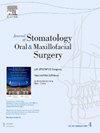Characterizing the unseen: Clinical and radiographic perspectives on unilateral condylar hyperplasia
IF 1.8
3区 医学
Q2 DENTISTRY, ORAL SURGERY & MEDICINE
Journal of Stomatology Oral and Maxillofacial Surgery
Pub Date : 2024-10-29
DOI:10.1016/j.jormas.2024.102129
引用次数: 0
Abstract
Objectives
Unilateral condylar hyperplasia (UCH), marked by progressive condylar growth, occurs between ages 11–30 with unclear etiology. This retrospective study aims to clarify the clinical, radiographic, and demographic features of UCH to improve its diagnosis and treatment.
Material and methods
Data for all patients included in this study were retrieved from the archive. Inclusion criteria were the diagnosis of UCH supported by a positive bone scan above 10% of condylar uptake in SPECT/CT, the patient's history of progressive facial asymmetry, symptoms confirmed by the orthodontist during follow-up, and clinical and radiological evaluation. Demographic characteristics, along with volumetric and linear measurements, were statistically evaluated.
Results
Forty-one patients were included in this study with 70.73% female predominance. Patients were classified as transverse and vertical type condylar hyperplasia (CH) according to their prominent asymmetry characteristics. Eighteen patients were classified as vertical type CH and 23 patients were classified as transverse type CH. Twenty had left-side condylar overgrowth, and 21 had right-side overgrowth. Condylar volume difference was significantly higher in vertical type CH patients compared to transverse type CH (p = 0.004). No correlation was found between growth rate (bone scan uptake ratio) and condylar volume difference in patients with vertical type and transverse type CH patients (p = 0.205).
Conclusion
Particularly in cases that exhibit a pronounced vertical growth tendency, volumetric and linear measurements can guide the timing and treatment planning process.
描述看不见的东西:单侧髁状突增生的临床和影像学视角。
目的:单侧髁状突增生(UCH)以髁状突逐渐增大为特征,多发于11-30岁之间,病因不明。本回顾性研究旨在明确单侧髁状突增生症的临床、影像学和人口统计学特征,以改进其诊断和治疗:本研究中所有患者的数据均来自档案库。纳入标准为:SPECT/CT 骨扫描阳性,髁突摄取超过 10%,确诊为 UCH;患者有进行性面部不对称病史;随访期间正畸医生确认症状;临床和放射学评估。对人口统计学特征以及体积和线性测量结果进行了统计评估:本研究共纳入 41 名患者,其中女性占 70.73%。根据患者突出的不对称特征,将其分为横向型和纵向型髁突增生(CH)。18名患者被归类为垂直型髁状突增生,23名患者被归类为横向型髁状突增生。20名患者为左侧髁突过度生长,21名患者为右侧髁突过度生长。垂直型CH患者的髁突体积差异明显高于横向型CH患者(p = 0.004)。纵向型和横向型CH患者的生长速度(骨扫描摄取比)与髁突体积差异之间没有相关性(p = 0.205):结论:特别是在垂直生长趋势明显的病例中,体积和线性测量可以指导治疗时机和治疗计划的制定。
本文章由计算机程序翻译,如有差异,请以英文原文为准。
求助全文
约1分钟内获得全文
求助全文
来源期刊

Journal of Stomatology Oral and Maxillofacial Surgery
Surgery, Dentistry, Oral Surgery and Medicine, Otorhinolaryngology and Facial Plastic Surgery
CiteScore
2.30
自引率
9.10%
发文量
0
审稿时长
23 days
 求助内容:
求助内容: 应助结果提醒方式:
应助结果提醒方式:


